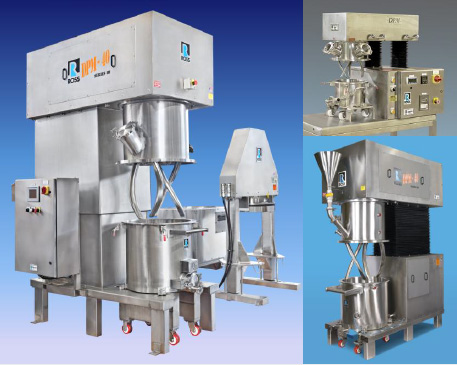Tech Report
Recommended Mixing Equipment for Pharmaceutical Gels

Application Summary
A majority of pharmaceutical gels are shear-thinning semi-solids prepared by dispersing hydrophilic polymers into an aqueous vehicle. Proper mixing typically requires a good balance between agitation and shear. For instance, polymers such as methylcellulose, sodium carboxymethylcellulose, hydroxyethylcellulose, carrageenan and polyacrylic acid need sufficient agitation to hydrate completely but may degrade under high shear conditions and elevated temperatures. The mixing mechanism must also be capable of quickly dispersing or dissolving other components (active ingredients, preservatives, colors, flavors, etc.) into the thickened gel.
Ross Double Planetary Mixers
Double Planetary Mixers are well-proven equipment for the processing of pharmaceutical gels. Traditional designs move material by rotating two rectangular-shaped paddles on their respective axes as they orbit on a common axis. The blades contact virtually every point of the batch in just 36 revolutions, imparting a very thorough but gentle mixing action.
Newer design helical blades offer improved mixing accuracy and tighter control on product purity. The first of its kind, Ross High Viscosity "HV" Blades (US Patent No. 6,652,137) feature a precisely angled contour which generates a unique mixing action: the sweeping curve firmly pushes batch material forward and downward, keeping it within the mixing zone at all times. The helical flights of the HV Blades pass each other in a slicing motion, enabling them to move through a viscous gel with less resistance. This agitation mechanism produces highly repeatable results with minimal risk of material degradation. Active ingredients and other minor components are quickly and uniformly distributed throughout the batch without damaging the physical integrity of the gel itself. Numerous Ross Double Planetary Mixers are installed across pharmaceutical production facilities around the world for processing this particular application and other sanitary formulations.
Other Sanitary Applications of Ross Double Planetary Mixers:
- Bone Graft Substitutes
- Collagen Solutions
- Dental Composites
- Filled Polymers
- Hydrogel Adhesives
- Implant Materials
- Medical-grade Silicones
- Ointments
- Pharmaceutical Cakes(Mixing and Vacuum Drying)
- Soft-gel Encapsulation Materials
- Tissue Substrates
- Toothpaste
- Viscous Foods (candies, fillings, cheese products)
- Wet Granulations
Some Advantages of Ross Double Planetary Mixerswith High Viscosity "HV" Blades

- Enhanced mixing accuracy. The helical High Viscosity Blades prevent batch materials from "climbing" up into the mixer cover and gearbox, an issue commonly experienced with conventional rectangular planetary stirrers. Another important feature is the flush discharge valve which eliminates any dead spots where batch materials can stagnate.
- Cleanability. There are no shaft seals, bearings, packing glands and stuffing boxes submerged in the product zone of the Double Planetary Mixer. Agitators are raised and lowered by a hydraulic lift allowing easy access for cleaning between batches.
- Change can design. Interchangeable mix cans may be designated to particular formulations. This feature further reduces the risk of cross-contamination between batches while allowing for semi-continuous operation when one mixer is used with multiple vessels.
- Fast and easy discharge. With the mix can positioned beneath a Ross Discharge System, a platen is lowered hydraulically into the vessel. A specially-fitted O-ring rides against the vessel, wiping the sidewall surfaces on its way down as product is forced out by the platen. The Discharge System eliminates wasted hours of scraping heavy or sticky gel materials from the mix vessel.